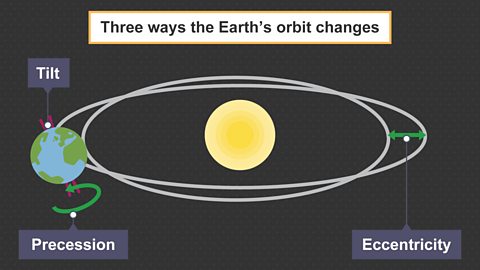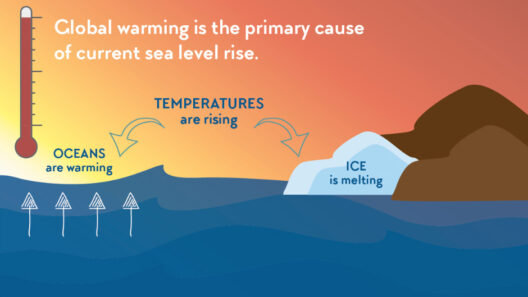The Earth’s climate is a complex and dynamic system influenced by numerous factors, one of the most significant being orbital changes. These orbital variations, also known as Milankovitch cycles, are essential in understanding long-term climate patterns and shifts. This article delves into the intricate relationship between Earth’s orbital mechanics and climate changes, providing insights into how these celestial dynamics affect our planet’s climate over millennia.
To comprehend orbital changes, it is imperative to first recognize the concept of Earth’s orbit. Our planet orbits the sun in an elliptical shape, and this path is not static. Three primary components contribute to changes in Earth’s orbit: eccentricity, axial tilt, and precession. Each of these elements operates on distinct timescales, and together, they orchestrate the complex dance of climate variabilities.
Eccentricity refers to the shape of Earth’s orbit around the sun. Over a cycle of approximately 100,000 years, the orbit transitions from nearly circular to more elongated. When the orbit is highly elliptical, the distance between the Earth and the sun fluctuates more dramatically throughout the year. This variance can lead to significant differences in solar radiation received by the planet. Consequently, a more elongated orbit can contribute to cooler phases, while a circular orbit may result in warmer conditions, particularly impacting glacial-interglacial cycles.
The second factor is axial tilt, or obliquity, which pertains to the angle at which Earth tilts on its rotational axis. The tilt varies from about 22.1 to 24.5 degrees over a cycle of approximately 41,000 years. This axial tilt plays a critical role in determining the severity of seasons. A greater tilt results in more pronounced seasonal contrasts — hotter summers and colder winters — while a reduced tilt leads to milder seasons. Such fluctuations can influence vegetation patterns, glacier formation, and ultimately, global temperatures.
The third significant mechanism is precession, which describes the wobble of Earth’s axis over a period of around 26,000 years. This wobble alters the timing of the seasons relative to Earth’s position in its orbit. As a result, precession affects how sunlight is distributed across the globe at various times of the year. In combination with eccentricity and axial tilt, precession can amplify or moderate seasonal climate variations, thereby shaping long-term climate phenomena.
As these orbital changes come into play, the cumulative effects can lead to profound climate transformations. During periods of greater eccentricity and increased axial tilt, the Earth may experience profound warming, subsequently leading to melting ice caps and rising sea levels. These processes can trigger feedback mechanisms that further exacerbate climatic shifts. For instance, decreased ice cover results in lower albedo, meaning that less sunlight is reflected back into space, causing the planet to absorb more heat.
In contrast, when the cycles point toward cooler conditions, glacial periods can ensue. These conditions promote the growth of ice sheets in polar regions, which in turn foster a range of ecological consequences. As ice expands, it can alter oceanic currents, significantly impacting marine biodiversity and atmospheric circulation patterns. Additionally, the expansion of glaciers can have far-reaching implications for freshwater availability, as glaciers serve as crucial reservoirs for many regions.
The impact of orbital changes extends beyond merely temperature fluctuations; it influences patterns of precipitation, biodiversity, and even the emergence and extinction of species. For example, during glacial maxima, arid conditions can dominate vast areas, transforming lush landscapes into deserts. Conversely, warmer interglacial periods can facilitate the proliferation of flora and fauna, creating conditions conducive to biodiversity but also possibly leading to further ecological competition.
Scientists rely on various methods to study the significant impacts of orbital variations on climate. Ice cores, sediment records, and tree rings hold valuable information on past climate conditions. These proxies enable researchers to reconstruct historical climate patterns and correlate them with known orbital changes. By analyzing these data, researchers can ascertain the extent of climate shifts and how they corresponded to specific orbital configurations.
The understanding of Earth’s orbital mechanics and their climatic implications is not merely an academic endeavor but holds essential practical significance as humanity confronts the challenges posed by contemporary climate change. Current anthropogenic influences drastically differ in scale and speed compared to natural orbital changes. Nevertheless, some lessons from the past may shed light on how ecosystems could respond to rapid climate shifts induced by human activities.
In conclusion, the intricacies of orbits and their multifaceted influences on climate are a testament to the dynamic interplay between celestial mechanics and terrestrial environments. As Earth’s orbit oscillates through its cycles, the resulting shifts can provoke significant transformations, shaping the planet’s climatic landscape over epochs. Understanding this delicate balance helps us appreciate the complexities of our climate system and the importance of mitigating human impacts to preserve the natural equilibrium fostered over millions of years. Through a comprehensive understanding of these orbital phenomena and their historical context, we can reflect on our place within this intricate tapestry of life and climate, prompting us to act with responsibility and foresight for future generations.





